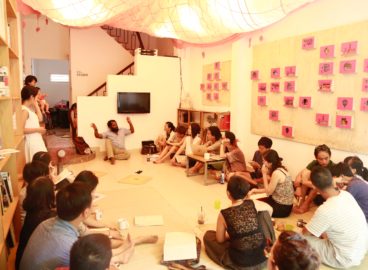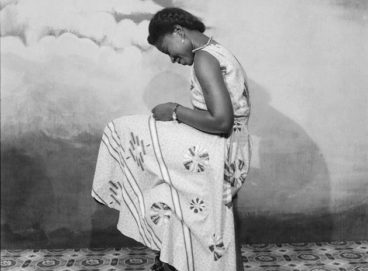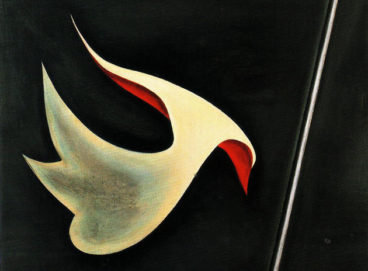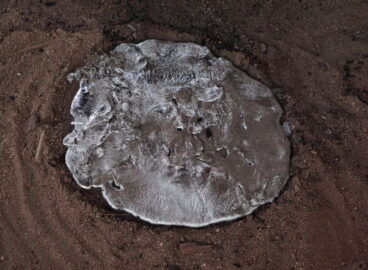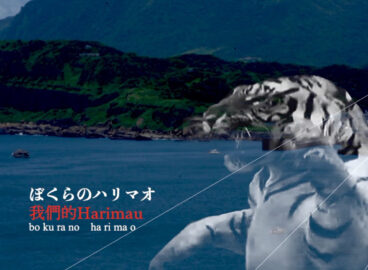In this brief essay, art historian Da Hyung Jeong proposes a reading of Soviet-built structures in the region. He attempts to reveal the intentions behind their construction through an analysis of Soviet-era cultural criticism, socioeconomic studies, and encyclopedia entries.
On October 4, 1957, the Soviet Union successfully launched Sputnik 1, the world’s first artificial satellite. A year later, Indonesian architect Oei Tjong An’s “Sputnik” pharmacy opened in Semarang, Indonesia, and gave expression to, through a proto-Pop vocabulary, the sense of technological optimism brought about by mankind’s first step toward space exploration (fig. 1). That the Soviets gained the upper hand in this endeavor alarmed Americans. As the Indonesian ambassador to the United States remarked in a 1957 interview: “Within the past month I have been asked repeatedly, ‘What is the effect of Sputnik on the people of Indonesia?,’ ‘Will this give the Asian people a feeling that the Soviet Union is a greater military power?,’” sensing “a fear, almost a panic” behind these questions.1“Neglected Text: The Indonesian Ambassador Wonders Why We Are So Panicky Over Sputnik,” I. F. Stone’s Weekly 5, no. 23 (December 1957): 4. The fear, it turned out, was justified—an Indonesian high school history textbook published in 1958 portrays the successful launch of Sputnik as an event that “shocked the whole world,” stating that America “lags far behind, managing to send Explorer I into space only in January 1958.”2Soeroto, Indonesia di tengah-tengah dunia dari abad keabad: peladjaran sedjarah untuk sekolah menengah III (Jakarta: Djambatan, 1958), 235.

Sukarno, president of newly independent Indonesia, visited Moscow in August 1956 and received a particularly distinguished welcome. The Soviet Academy of Sciences awarded him an honorary doctorate of law, while Moscow State University appointed him honorary professor. “First-class motion picture and television films” were made to commemorate his visit, and these would go on to be “widely shown” throughout Indonesia.3Frederick C. Barghoorn, “The New Cultural Diplomacy,” Problems of Communism 7, no. 4 (July–August 1958): 43. Four years later, in February 1960, Soviet premier Nikita Khrushchev returned the visit, spending ten days in Indonesia. When Sukarno “asked the USSR to build a grandiose and quite expensive stadium in the capital city,” Khrushchev was “surprised,” later remembering the exchange as follows: “‘What do you want that for?’ I asked Sukarno. ‘To hold large public rallies,’ he answered. Theatricality was a negative feature of his. Among the leaders of countries I have known, he distinguished himself in this capacity more than anyone else. Nehru, for example, was a completely different kind of man. Of course the leader of a country has to address large public meetings. But Sukarno displayed a particular weakness for that kind of thing.”4Sergei Khrushchev, ed., Memoirs of Nikita Khrushchev, vol. 3, Statesman, 1953–1964 (University Park, PA: Pennsylvania State University Press, 2007), 788.
The stadium, now known as Gelora Bung Karno Stadium, soon came to symbolize the 1962 Asian Games, held in Jakarta from August 24 to September 4. Sukarno considered the games as a “means of showing his power and of letting independent Indonesia’s beacon radiate more strongly into the world, pushing back the borders of the other newly independent Asian nations.”5Stefan Huebner, Pan-Asian Sports and the Emergence of Modern Asia, 1913–1974 (Singapore: NUS Press, 2016), 176. The structure was designed by R. I. Semerdzhiev, Iu. V. Raninskii, K. P. Pchel’nikov, and L. A. Muromtsev, architects and engineers affiliated with the Moscow-based architectural collective Mosproekt-2 (fig. 2). Khrushchev held that the construction of the stadium, which upon completion would become the largest in Asia, would be “a question of prestige for the Indonesian nation.”6G. S. Akopian, Ekonomicheskoe sotrudnichestvo Sovetskogo Soiuza s ekonomicheski slaborazvitymi stranami (Moscow: Izd-vo In-ta mezhdunarodnykh otnoshenii, 1962), 101. In a 1973 survey of recent architecture in Southeast Asia, historian S. S. Ozhegov cites the project as a stellar example of socialist construction distinguishing itself from capitalist and, by extension, imperialist construction. He notes that the emphasis is “not on office buildings, banks and hotels but rather on educational institutions, hospitals and sports complexes” that would serve as nodes in new neighborhoods and communities planned for underdeveloped areas.7S. S. Ozhegov, “Arkhitektura stran iugo-vostochnoi Azii,” in Arkhitektura kapitalisticheskikh stran XX v., eds. A. V. Ikonnikov et al. (Moscow: Izd-vo literatury po stroitel’stvu, 1973), 767. Indeed, the stadium and the other facilities forming the new sports complex became the centerpiece of what had formerly been a “deserted suburban district,” granting it, in effect, new life.8Ibid., 770.
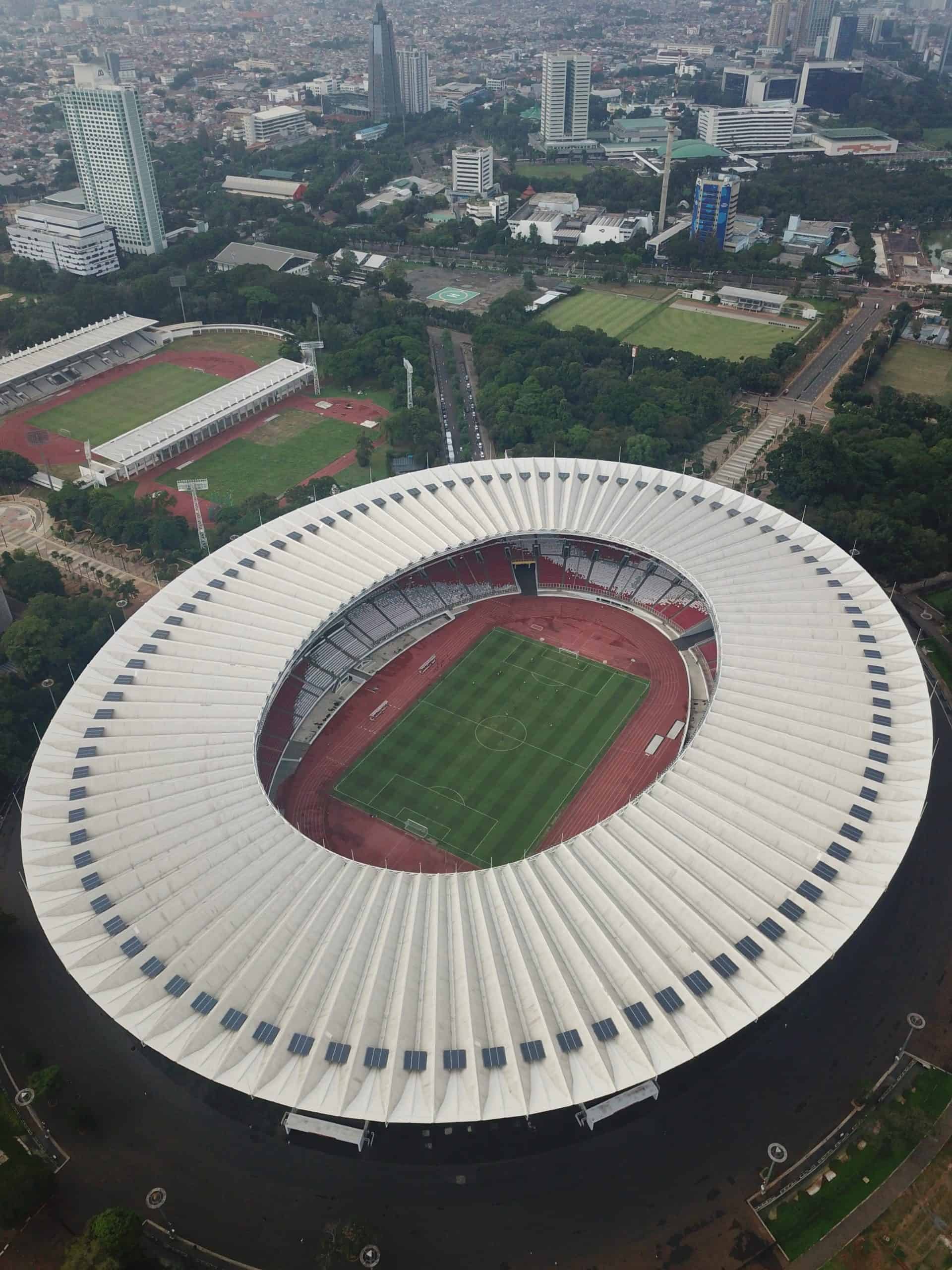
The Sputnik panic added to the uneasiness that the United States and its allies, struggling for dominance in Southeast Asia, had increasingly felt as a result of extensive Soviet aid to newly independent states in the region. Observing the situation in Burma, British diplomat Paul Gore-Booth remarked that “Communist trade, Communist experts and Communist-designed and erected buildings could be followed by Communist arms, Communist ideas, and ultimately, Communist control of this country.”9Matthew Foley, The Cold War and National Assertion in Southeast Asia: Britain, the United States and Burma, 1948–1962 (London: Routledge, 2010), 121. After Burma was among the countries that Anastas Mikoyan, first deputy premier of the Soviet Union, visited on his 1956 “Asia tour,” a National Security Council briefing reported that his “good-will junket” yielded “concrete results”—among which was an agreement that made the Soviet Union Burma’s largest rice customer, with four hundred thousand tons offered annually for four years in exchange for “architectural gifts.”10“NSC Debriefing, April 5, 1956: Mikoyan’s Asia Tour,” United States Central Intelligence Agency Archives. However, Burma’s nonalignment meant that in Rangoon, Soviet-built structures would come to coexist with British architect Raglan Squire’s University of Medicine, American architect Benjamin Polk’s Tripitaka Library, and the Chinese-built National Theater, among others.
The Rangoon Polytechnic Institute, designed by Pavel Steniushin in 1958, is a notable example of Soviet architecture in Burma. The general austerity of the building’s form is offset by the expressivity of the roof structure, whose curvature evokes Buddhist temple architecture (fig. 3). Steniushin was associated with GIPROVUZ (Gosudarstvennyi institut po proektirovaniiu vysshikh uchebnykh zavedenii, State Institute for the Design of Higher Education Establishments), another Moscow-based collective that oversaw the construction of university buildings not only within the Soviet Union but also abroad—for instance, in Afghanistan, Burma, Cameroon, Ethiopia, Indonesia, Mali, and Mongolia, among other nations. He would, two years later, in 1960, help conceive the Polytechnic University in Kabul, Afghanistan. In Rangoon, the emphasis was on enlivening an underdeveloped suburban area. Capable of accommodating up to one thousand students, the institute became vital to the life of the district and would soon grow into the “most important center for the preparation of specialists for many diverse branches of the national economy,” including architecture.11S. S. Ozhegov, Arkhitektura Birmy (Moscow: Nauka, 1970), 184. In 1970, diplomat N. N. Sofinskii indicated that “lectures have been given by 90 of our [Soviet] lecturers at different times in the auditoriums of the Rangoon Polytechnhic Institute,” and among those who held visiting professorships was A. E. Korotkovskii, an architect from Novokuznetsk, Russia. Korotkovskii divided his time in the Burmese capital between teaching and design, which included taking part in a competition for a new building for Rangoon University’s Palace of Culture for Students in 1965.12N. N. Sofinskii, “Plodotvornoe sotrudnichestvo,” Kommunist 15 (October 1970): 112.

In Phnom Penh, Cambodia, the Khmer-Soviet Friendship Hospital was completed with Soviet aid in 1960 (fig. 4). Its gateway features an undulating roof that, alluding to the “Chaika” swimming pool in Moscow, serves as a reminder that many of the Soviet architects active in Southeast Asia had been previously based in Moscow. As soon as avant-garde groups experimented with novel approaches to design and methods of standardized construction in the Soviet capital, these new ideas and innovations were exported abroad and meant to signify, though not always with success, the cutting edge of Soviet architecture. The hospital, along with the polytechnic institute, required an expert staff for its upkeep, and this became a pretext for the long-term presence of Soviet “advisors” thought to ensure ongoing Soviet dominance in a given region. N. L. Iakobson, architect of the project, was affiliated with GIPROZDRAV (Gosudarstvennyi institut po proektirovaniiu ob”ektov zdravookhraneniia), an entity similar to GIPROVUZ that specialized in buildings related to healthcare and recreation. An entire residential district was planned in conjunction with the hospital, which became its pivot.
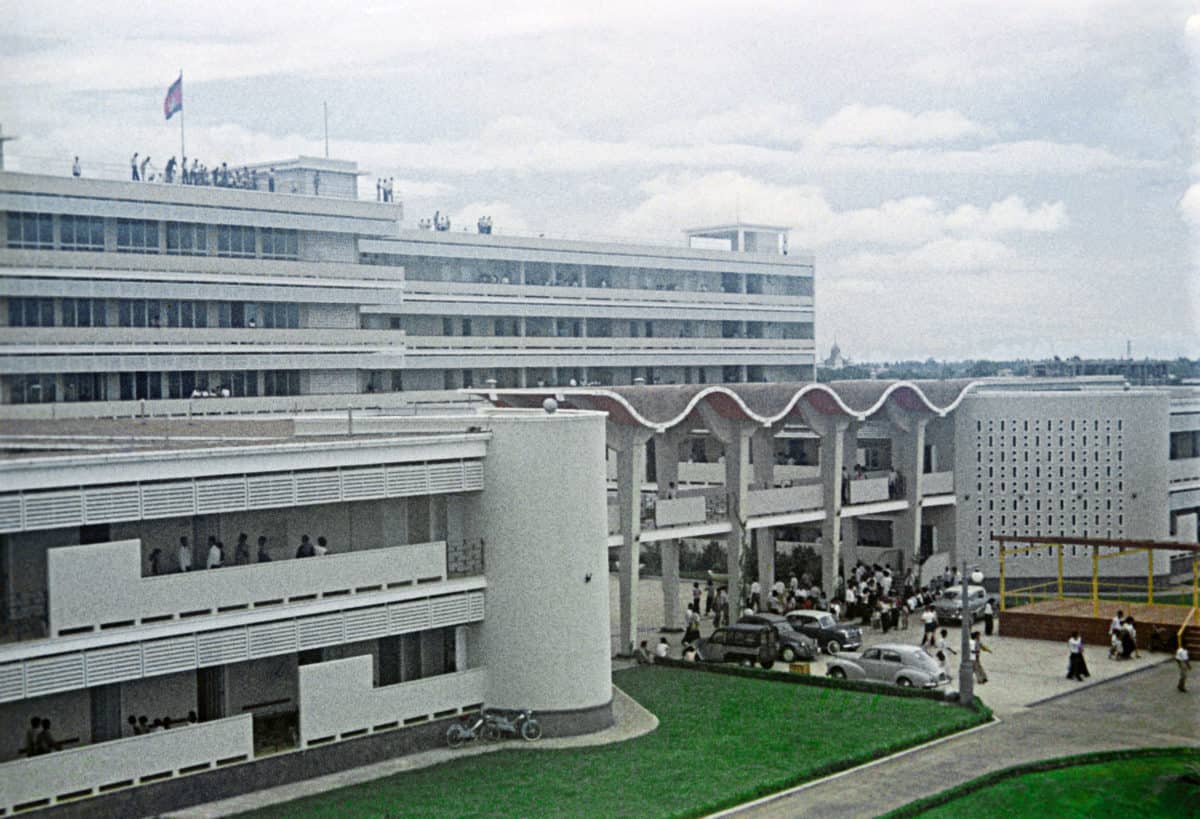
A section of the entry on Phnom Penh in The Great Soviet Encyclopedia is devoted to architecture. Here, the Khmer-Soviet Friendship Hospital, along with the Superior Technical Institute of Khmer-Soviet Friendship built in 1964 by S. N. Mikhailov, A. V. Mochalov, and V. P. Naumov, is mentioned in the same breath as the Cambodian modernist architect Vann Molyvann’s 1961 Chaktomuk Conference Hall, 1964 National Sports Complex, and 1960 Independence Monument, a photograph of which accompanies the text. As early as 1965, just four years after the completion of the Chaktomuk Conference Hall, the painter-pedagogue Boris Ioganson’s encyclopedia of world art had already singled out the building, characterizing it as a work in a “contemporary style” combining Western methods learned in Paris with traditional knowledge.13B. V. Ioganson, ed., Kratkaia khudozhestvennaia entsiklopediia. Iskusstvo stran i narodov mira: arkhitektura, zhivopis’, skul’ptura, grafika, dekorativnoe iskusstvo (Moscow: Sovetskaia entsiklopediia, 1965), 369. Soviet critics praised Vann Molyvann’s buildings as representing the “national” and, by extension, serving as postcolonial counterparts to the region’s international architecture.14S. S. Ozhegov, “Arkhitektura stran iugo-vostochnoi Azii,” 760.
At the conclusion of the violent Khmer Rouge rule, which lasted from 1975 to 1979 and is poignantly encapsulated by Tuol Sleng, the high school–turned–prison and torture and execution center where tens of thousands lost their lives, the Soviet Union resumed its interrupted aid to Cambodia, now known as the People’s Republic of Kampuchea. This time, architects were not dispatched to design new buildings but rather to oversee the repair of existing buildings that had suffered damage as a result of politically motivated vandalism and the Cambodian-Vietnamese War. Among these was Vann Molyvann’s National Bank of Cambodia and, offering a striking image that juxtaposes the destruction of “hundreds of Buddha statues” with the dynamiting of the bank, E. V. Kobelev’s 1985 Kampuchiia: spravochnik (Kampuchea: A Reference) explicitly portrays Soviet repair efforts as the reversal of the merciless destruction of material heritage and the erasure of cultural identity committed by the anti-Soviet, Chinese-backed Khmer Rouge regime.15Iu. P. Dement’ev, I. S. Kazakevich and E. V. Kobelev, eds., Kampuchiia: spravochnik (Moscow: Izd-vo “Nauka,” 1985), 166. Until its dissolution in 1991, the Soviet Union continued to attempt to exert influence in the region, providing, for instance, “considerable economic and military assistance to Vietnam in support of its policy in Cambodia.”16Michael Leifer, Dictionary of the Modern Politics of Southeast Asia (London and New York: Routledge, 2012), 277.
- 1“Neglected Text: The Indonesian Ambassador Wonders Why We Are So Panicky Over Sputnik,” I. F. Stone’s Weekly 5, no. 23 (December 1957): 4.
- 2Soeroto, Indonesia di tengah-tengah dunia dari abad keabad: peladjaran sedjarah untuk sekolah menengah III (Jakarta: Djambatan, 1958), 235.
- 3Frederick C. Barghoorn, “The New Cultural Diplomacy,” Problems of Communism 7, no. 4 (July–August 1958): 43.
- 4Sergei Khrushchev, ed., Memoirs of Nikita Khrushchev, vol. 3, Statesman, 1953–1964 (University Park, PA: Pennsylvania State University Press, 2007), 788.
- 5Stefan Huebner, Pan-Asian Sports and the Emergence of Modern Asia, 1913–1974 (Singapore: NUS Press, 2016), 176.
- 6G. S. Akopian, Ekonomicheskoe sotrudnichestvo Sovetskogo Soiuza s ekonomicheski slaborazvitymi stranami (Moscow: Izd-vo In-ta mezhdunarodnykh otnoshenii, 1962), 101.
- 7S. S. Ozhegov, “Arkhitektura stran iugo-vostochnoi Azii,” in Arkhitektura kapitalisticheskikh stran XX v., eds. A. V. Ikonnikov et al. (Moscow: Izd-vo literatury po stroitel’stvu, 1973), 767.
- 8Ibid., 770.
- 9Matthew Foley, The Cold War and National Assertion in Southeast Asia: Britain, the United States and Burma, 1948–1962 (London: Routledge, 2010), 121.
- 10“NSC Debriefing, April 5, 1956: Mikoyan’s Asia Tour,” United States Central Intelligence Agency Archives.
- 11S. S. Ozhegov, Arkhitektura Birmy (Moscow: Nauka, 1970), 184.
- 12N. N. Sofinskii, “Plodotvornoe sotrudnichestvo,” Kommunist 15 (October 1970): 112.
- 13B. V. Ioganson, ed., Kratkaia khudozhestvennaia entsiklopediia. Iskusstvo stran i narodov mira: arkhitektura, zhivopis’, skul’ptura, grafika, dekorativnoe iskusstvo (Moscow: Sovetskaia entsiklopediia, 1965), 369.
- 14S. S. Ozhegov, “Arkhitektura stran iugo-vostochnoi Azii,” 760.
- 15Iu. P. Dement’ev, I. S. Kazakevich and E. V. Kobelev, eds., Kampuchiia: spravochnik (Moscow: Izd-vo “Nauka,” 1985), 166.
- 16Michael Leifer, Dictionary of the Modern Politics of Southeast Asia (London and New York: Routledge, 2012), 277.
